The approximate geographical locations of where the coins were issued can be seen on this map
(identify coins by their coin numbers). Coins of large empires are located in the area of the presumed capital cities.

|
|
|

|
Coin #30:
Ghaznavid, Mahmud of Ghazni, Silver dirhem, dated AH 418 = 1027-28 CE
Persian legend /
Sanskrit legend
Weight: 2.84 gm., Diam: 19 mm.
Ref: Goron and Goenka GZ 5 |
|
The Islamic presence in Sind, first established in the 7th century, was somewhat tentative even up to the 10th century. However, further north, Islamic rule arrived and
became established very quickly in the hands of Mahmud of Ghazni. The Ghaznavid dynasty was of Turkish origin, but had established its base in Ghazni in Afghanistan.
Mahmud, the son of the founder of the dynasty, embarked on a major military campaign, as a result of which he became the ruler of most of present-day Afghanistan, Iran,
Pakistan and northwestern India. Although the Ghaznavid rule ended in the 12th century, it was replaced by another Islamic dynasty: the Ghorids (see coin 33 later). Muslims
were to hold sway over much of northern India for over 700 years, until the arrival of the British.
Coin 30 is a remarkable early Islamic coin of India. It is an issue of Mahmud of Ghazni, minted at Lahore and dated 418 in the Islamic Hejira era, equivalent to 1027-28 CE.
What is particularly remarkable about it is that it is bilingual: it carries legends in both Persian and Sanskrit. Most Islamic coins of India simply carry legends in Persian. But this
early coin reflects a more compromising attitude, in that the local population is approached through the presence of Sanskrit on the coin. The Sanskrit legend, a translation of
the Persian on the obverse, states: avyaktameka muhammada avatar nripati mahamuda (the Invisible is One, Muhammad is the manifestation, Mahmud the king).
To see the approximate geographical location of where this coin was issued, look for the number 30 on this map.
|
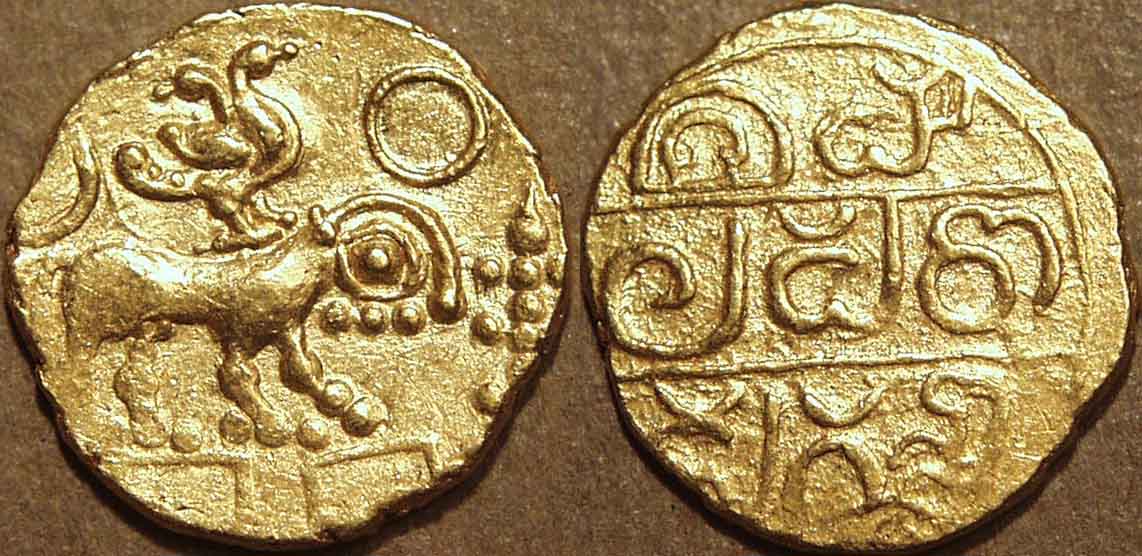
|
Coin #31:
Hoysala, Vinayadita "Sri Malaparolugonda", Gold pagoda or gadyana, c. 1047-1100 CE
Sardula right with Gandabherunda above, lamp before,
sun and moon above /
Three line Kannada legend: Sri Malaparolugonda
Weight: 3.98 gm, Diameter: 17 mm.
Ref: unpublished |
|
For the first few centuries, the Islamic encroachment in India was confined to the north. In South India, Hindu kingdoms continued to rule and to vie with one another for
supremacy. The Chalukyas, Rashtrakutas, Yadavas, Silaharas, Kadambas, Gangas, Kakatiyas, Hoysalas, Alupas, Cholas and Pandyas, and other minor dynasties, at
various times ruled various parts of peninsular India.
Coin 31 is a coin of one of these dynasties: an 11th century issue of the Hoysala king Vinayaditya. The Hoysalas were a dynasty that started out as feudatory to the
Chalukyas, but eventually they became independent and ruled a substantial kingdom that included almost all of the modern state of Karnataka plus some of the surrounding
territory. The obverse of this coin features a stylized tiger or lion, known as a sardula, surmounted by a double-headed eagle known as a gandabherunda. A tiger features
prominently in the story or legend about the origins of the Hoysala dynasty, and their king called himself Malaparolugonda (Lord of the Hills, from the original homeland in the
western mountains of south India) and Gandabherunda, a form of Lord Vishnu. The reverse of the coin in fact features the legend Sri Malaparolugonda.
To see the approximate geographical location of where this coin was issued, look for the letter F on this map.
|
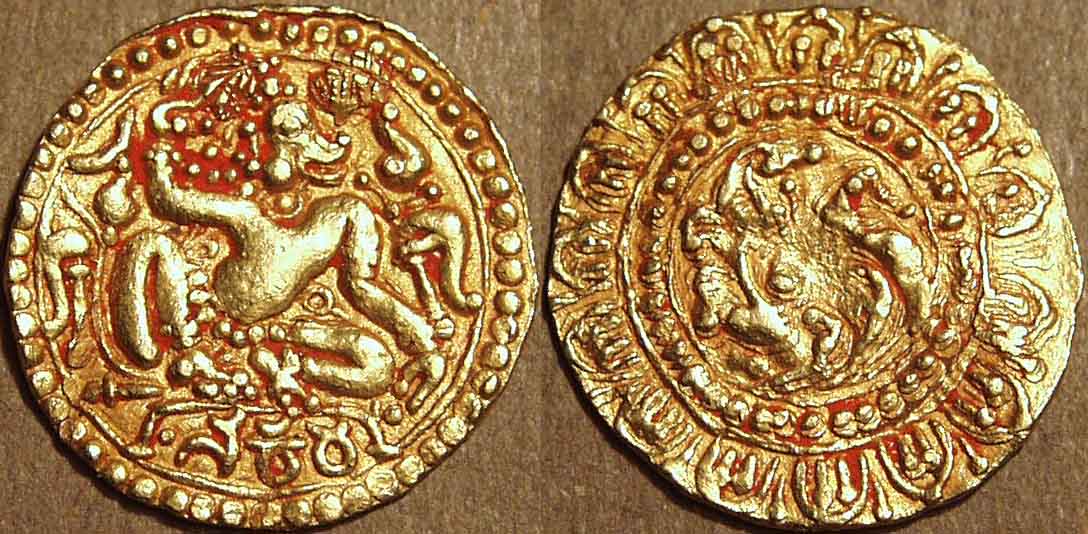
|
Coin #32:
Kadambas of Hangal, Anonymous, naming Nakareshwar, Gold pagoda or gadyana,
c. 11th-12th century CE
Hanuman seated facing, head turned to right,
surrounded by Vaishnava symbols, Kannada legend below: Nakara /
Floral design within highly decorative borders
Weight: 4.28 gm, Diameter: 20 mm.
Ref: MNI 666 |
|
Coin 32 is an issue from another of the major southern dynasties: the Kadambas of Hangal, who ruled in what is now western Karnataka state during the 11th and 12th
centuries and produced some very attractive die-struck coins, such as this gold pagoda or gadyana, featuring the monkey deity Hanuman enthroned and surrounded by
various Vaishnava symbols. Below is a Kannada legend Nakara, in honor of Nakareshwar, the chief deity of the Hangals. By this time, the Kannada script, derived from
Brahmi, had differentiated itself from other regional scripts which had also evolved from the same source. The coin displays another interesting feature: within its crevices is a
red powder, sindoor or vermilion, that is used in Hindu worship rituals. Thus the coin has no doubt been used for this purpose.
To see the approximate geographical location of where this coin was issued, look for the letter F on this map. |
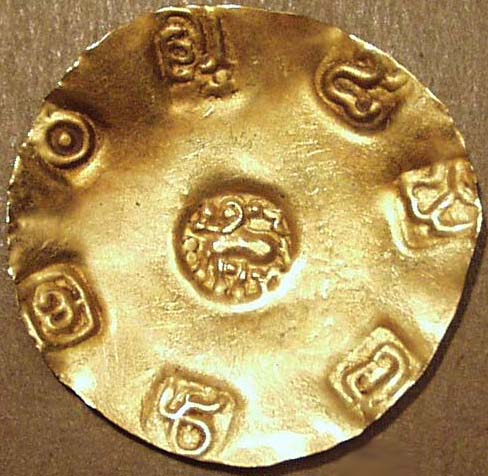
|
Coin #33:
Nagas of Chakrakota, Someshwar II, Gold pagoda or gadyana, c. 12th century CE
Tiger standing left in central punch, surrounded by
Kannada legend in 7 punches (starting at 8 o'clock): sri ra (sri) ja bhu sha na /
Incuse punches
Weight: 3.73 gm, Diameter: 36 mm.
Ref: Prabhu Sanoor JONS 206, p. 18, No. 4 |
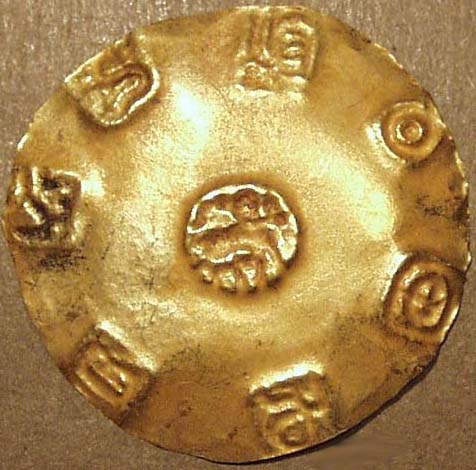
|
Coin 33 is a coin of one of the minor dynasties from south India:
a 12th century issue from the kingdom of the Nagas of Chakrakota. This dynasty waged war successfully against both the Eastern Chalukyas to the north and the
Cholas to the south, establishing a sizable kingdom. Note that the method by which this coin was manufactured is the old punchmark technique. Although few coins
were being minted in South India, somehow the punchmark technique survived and was revived at this time. The punches here include a central punch with a tiger, the
dynastic symbol of the Cholas, which Somesvara seemed to adopt in his southern province, and the peripheral punches which spell out in Kannada letters the legend
Sri Rajabhushana, an epithet of Somesvara II. The coin is extremely rare. Coins similar to this in style were being issued by some of the major dynasties as well, such as
the Chalukyas and the Cholas.
To see the approximate geographical location of where this coin was issued, look for the number 33 on this map. |
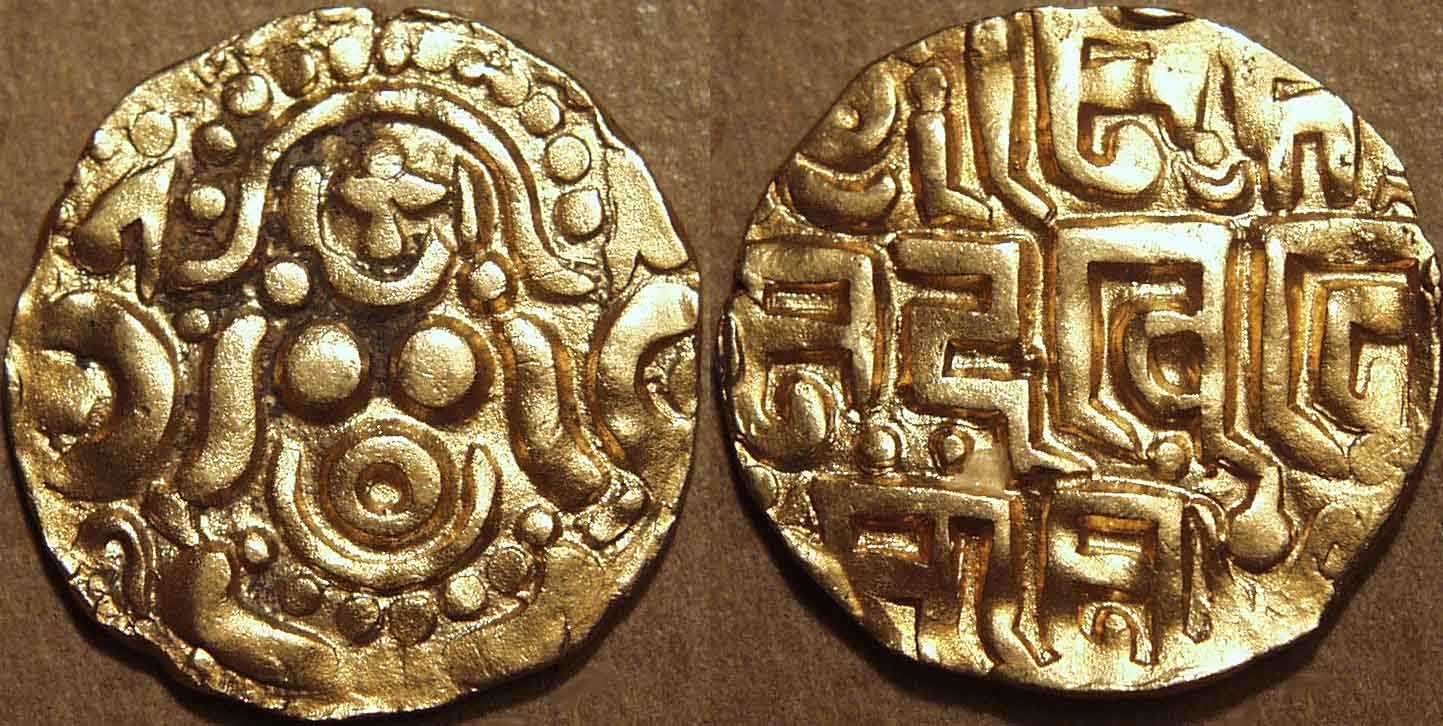
|
Coin #34:
Ghorids, Muhammad bin Sam, Gold 4-1/2 masha, c. late 12th century CE
Goddess (Lakshmi) seated cross-legged facing /
Three line Nagari legend: sri maha / mada bini / sam
Weight: 4.17 gm, Diameter: 21 mm.
Ref: Prabhu Sanoor JONS 206, p. 18, No. 4 |
|
Coin 34 shows another script descended from Brahmi:
Devanagari, which is the script in which modern Hindi is written. The coin is an issue of Muhammad bin Sam, more generally known as Muhammad of Ghor. He and his
brother captured Ghazni from the Ghaznavids in 1160. While his brother became Sultan, Muhammad waged war into the eastern part of the Ghaznavid empire and,
having captured that, pushed further into Rajput controlled territory in northern India. After a major defeat at the hands of Prithviraj Chauhan in 1191, Muhammad
returned the following year and won a resounding victory, establishing Ghorid rule over much of today's Rajasthan, Punjab, Haryana and western Uttar Pradesh.
The coin is a gold dinar or four and a half masha, issued by Muhammad Ghor in the style of the existing coinage of the Rajput clans, such as the Chauhans, the
Chandellas and the Gahadavalas. It features a seated Lakshmi on the obverse and a legend in Devanagari on the reverse. The legend reads Srimad Muhamad bini
Sam. Further west, Muhammad Ghor had also issued coins in the style of the previous coinage of the Hindu Shahi kings. The fully Islamic style coins waited for his
successors, the so-called slave kings.
To see the approximate geographical location of where this coin was issued, look for the number 34 on this map. |
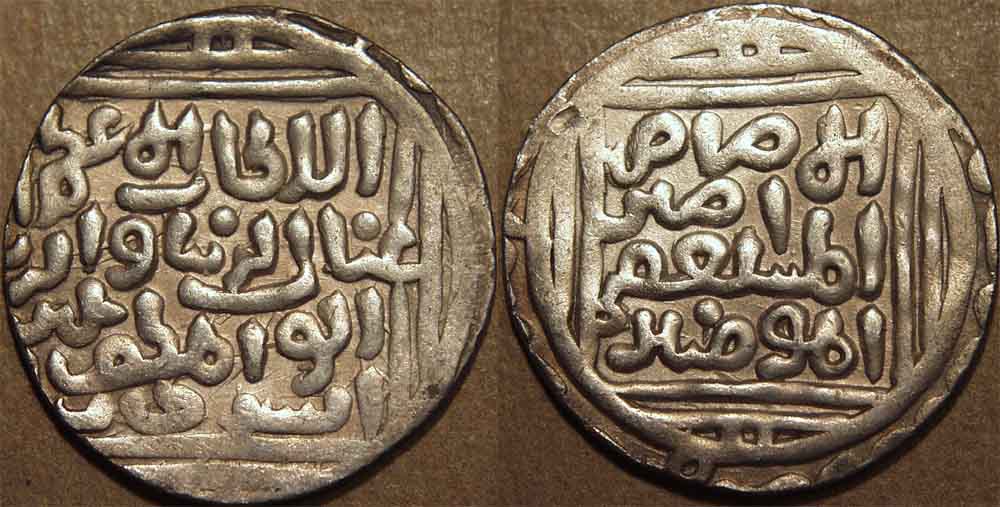
|
Coin #35:
Delhi Sultanate, Slave Dynasty, Ghiyath al-din Balban, Silver tanka, 1266-1287
Legend naming Balban /
Legend naming the Caliph, al-Must'asim
Weight: 10.79 gm, Diameter: 30 mm.
Ref: Goron and Goenka D 158 |
|
Muhammad Ghori did not have any sons. Instead, he trained his slaves to take on positions of responsibility, and even to succeed him. One of these slaves was
Qutb-ud-din Aibak, who, as a general in the Ghorid army, conquered Delhi and was appointed its viceroy. After Muhammad Ghori's death, Aibak established himself as
the Sultan, and moved the capital of the empire to Delhi. In this way, he established the Delhi Sultanate, ruled by the so-called Slave dynasty, as the first several sultans
were ex-slaves. At this time, the Sultanate stretched from Afghanistan all the way to Bengal.
An interesting fact about the slave dynasty is that one reign was of a short-lived queen, Razia Sultana, who ruled 1236-40. She was one of the very few female rulers in
Muslim history. Despite the fact that she was an able administrator, she faced considerable internal opposition and was eventually murdered by her opponents in the
court.
Coin 35 is an issue of one of these slave sultans: Ghiyath al-din Balban, who ruled 1266-87. The silver tanka is very much representative of the coinage of this dynasty.
It names Balban as the Sultan on the obverse and names on the reverse the Caliph in Baghdad, in this case al-Must'asim. Thus the sultans claimed their legitimacy from
the Baghdad Caliphate.
To see the approximate geographical location of where this coin was issued, look for the letter H on this map.
|

|
Coin #36:
Yadavas of Devagiri, Ramachandra, Gold pagoda "padmatanka," 1270-1311
Central lotus, surrounded by five separate punches:
Legend punch: sri rama, Kannada sri x 2, conch, and Nagari sri /
Blank
Weight: 3.79 gm, Diameter: 17 mm.
Ref: MNI 645 |
|
With coin 36, we turn south again. The coin is a new type of punchmarked coin: a gold pagoda of the Yadavas of Devagiri, a city now in the state of Maharashtra (and
called Daulatabad). The Yadavas were a clan from northern India, who claimed descent from Lord Krishna, the famous character in the Hindu epic The Mahabharata
and expositor of the philosophy of the Bhagavad Gita. They began as feudatories first of the Rashtrakutas and then of the Chalukyas, but eventually became
independent and ruled a substantial kingdom that included large parts of Maharashtra, Karnataka and Madhya Pradesh. They were eventually subdued and conquered
by the Sultans of Delhi.
In their coinage, the Yadavas placed a central punch on a relatively small flan. The violence of the strike rendered the coin cup-shaped, much like India's first coins
(see coin 1: the silver coin of the Shakya janapada). The central punch was always a lotus flower, emblem of Lord
Vishnu. The flower was then surrounded typically by four other punches. At the top would be the name of the king, in this case Ramachandra (the legend reads Sri
Rama in Devanagari letters), who ruled 1270-1311. On either side would be two punches of the letter Sri in Kannada script, a symbol of auspiciousness. And at the
bottom would be a punch of a conch shell, another emblem of Lord Vishnu. This particular coin is a rare variety in which there is a fifth peripheral punch, the letter Sri in
Devanagari script at around 8 o'clock. It was during Ramachandra's reign, at the end of the 13th and the start of the 14th century, that the Yadavas lost their
independence to the Delhi Sultanate, the first major incursion of Muslim power in southern India.
To see the approximate geographical location of where this coin was issued, look for the number 36 on this map.
|
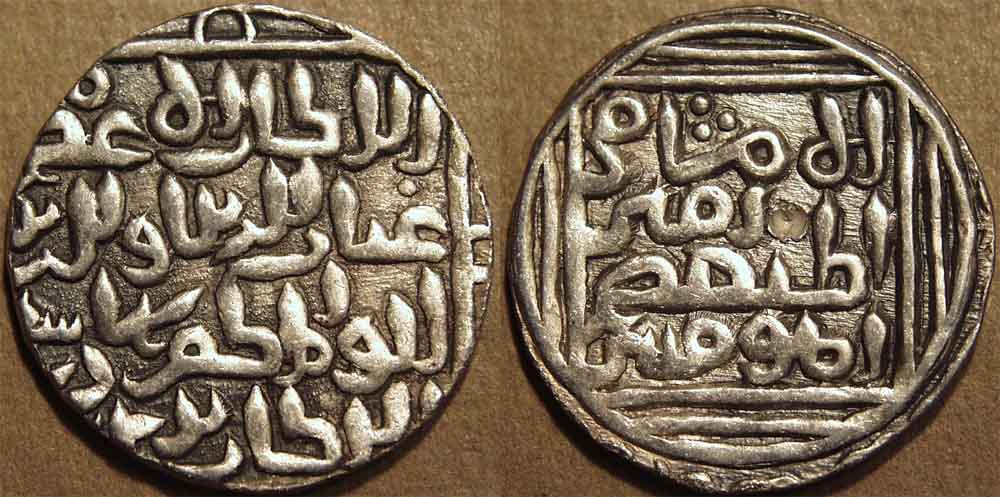
|
Coin #37:
Bengal Sultanate, Ghiyath al-din Bahadur, Silver tanka, 1320-1324
Legend: al-sultan al-a'zam ghiyath al-dunya wa'l din abu'l muzaffar bahadur shah
al-sultan bin sultan /
Legend: al-imam al-musta'sim amir al-mu'minin,
marginal legend with AH date and mint Lakhnauti
Weight: 10.87 gm., Diameter: 27 mm., Die axis: 4 o'clock
Ref: GG B108, Raj 167 |
|
The general who led the Delhi armies against the Yadavas was Ala-ud-din Khilji, and he used the success of his campaign to seize control of Delhi. This spelled the end of the
Slave dynasty and the establishment of the Khilji period of the Delhi Sultanate. Not only was Ala-ud-din's hand strengthened by his military successes, but the Delhi Sultanate's
central power had weakened after Balban (see coin 35 above), as the governors in Bengal had begun to assert their independence and had established a separate Bengal
Sultanate.
Coin 37 is an issue of this new sultanate. Comparing it to coin 35, we see that it directly continues in the manner of the Delhi coinage. It names the sultan, Ghiyath al-din Bahadur,
on the obverse and the caliph (imam) al-Musta'sim on the reverse. Soon after this coin was issued, Bengal was again brought under the control of Delhi, now ruled by the
Tughluqs, but by the middle of the 14th century, Bengal once again became independent.
To see the approximate geographical location of where this coin was issued, look for the letter G on this map.
|
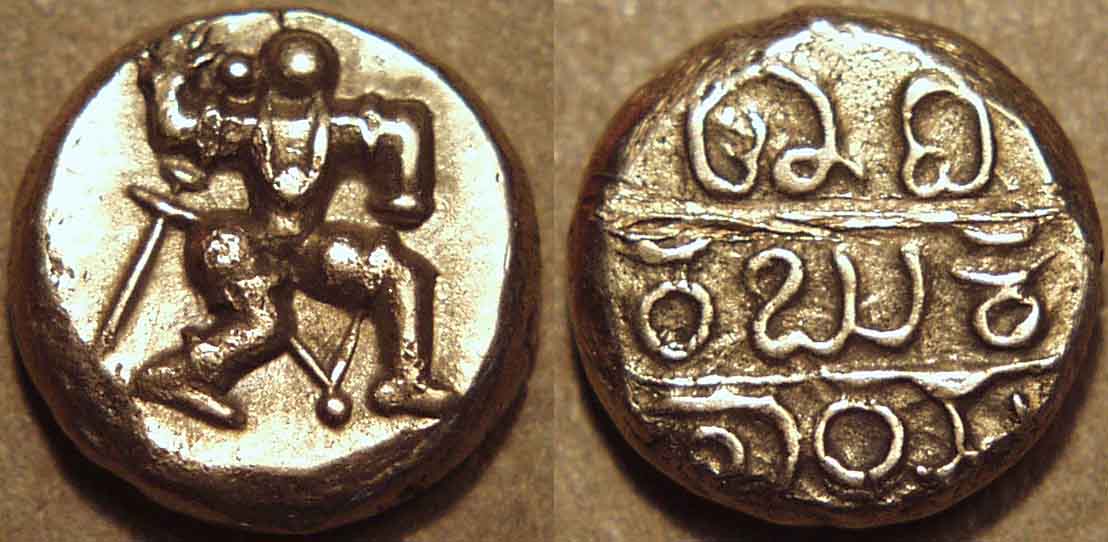
|
Coin #38:
Vijayanagar Empire, Bukka Raya I, Gold pagoda, 1344-1377
King striding right, in a pose to resemble Hanuman /
3-line Kannada legend: sri vi / ra buka / rayalu
Weight: 3.35 gm, Diameter: 13 mm.
Ref: MSI 392 |
|
Although Muslim rule had begun to spread into south India, and
perhaps even because of this, the 14th century saw the emergence of perhaps the most powerful Hindu kingdom ever seen in the south: the Vijayanagar empire. Its origins are
uncertain. At this time, many of the Hindu kingdoms of the south, such as the Yadavas, the Kakatiyas and the Pandyas had come under Muslim rule; only the Hoysala kingdom
was still holding out. Some historians believe that the founders of the Vijayanagar empire, Harihara and Bukka, were Hoysala generals charged with the task of stopping the
Muslim expansion. In fact, they waged war against many of their Hindu neighbors and consolidated them all into one empire that stretched from the east coast to the west coast
and all the way south to the tip of the peninsula. Of course this powerful kingdom then did become a bulwark against Muslim expansion further south.
Coin 38 is a gold pagoda of Bukka Raya I that epitomizes the confident new empire. Its obverse features a figure standing right, with a sword or dagger at the hip and the right
arm raised as if to strike a blow. Some have identified the figure as Hanuman, the monkey deity and the symbol of supreme service and bravery. However, I believe this is not so.
There are copper coins showing Hanuman in a similar pose, but the gold coin shows no sign of the tail that must of necessity be depicted if Hanuman is the intended figure. I
therefore believe that the king has indulged in a bit of propaganda, much like the Pratihara king Bhoja did on coin 26 above.
He has placed his own figure on the coin, but in a pose similar to that of his chosen deity in contemporary iconography in order to imply an identification of himself with Hanuman.
The reverse of the coin is a declaration of the issuer. It reads, in Kannada letters, Sri Vira Buka Raya. This particular specimen is remarkable for showing both obverse and
reverse designs fully on the flan.
To see the approximate geographical location of where this coin was issued, look for the number 38 on this map. |
|
|